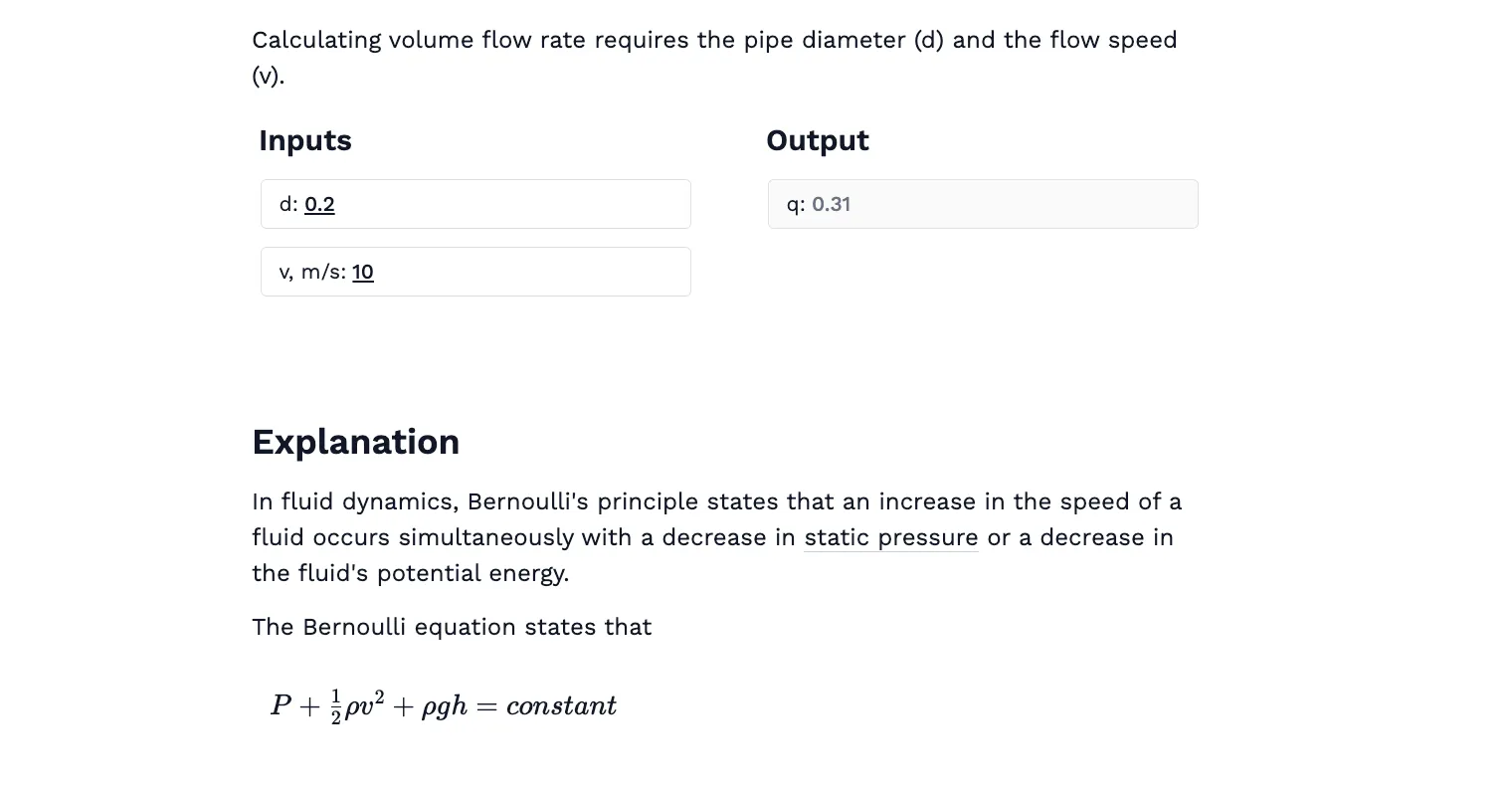Free Bernoulli Flow Calculator. Step-by-step, engineering-grade tool with downloadable report.

This template is not available yet. You can sign up and create it yourself!
Or let us know if you'd like to be notified when it’s ready:
About this 'Bernoulli Calculator'
The Bernoulli Calculator is a free-to-use online calculator for calculating volume and mass flow rates based on Bernoulli’s Equation. Bernoulli’s principle explains that an increase in the speed of a fluid results in a simultaneous decrease in static pressure or potential energy.
The calculator can determine unknown variables such as pressure, velocity, and flow rate at different points in a system.
This calculator is for:
- Mechanical Engineers: evaluate pressure loss, velocity gain, or energy conversion in pipelines, pumps, and ducts.
- Civil Engineers: Evaluate fluid behavior in hydraulic systems, such as flow behavior in water distribution networks and hydraulic structures.
- Students and Educators: Explore the applications of Bernoulli’s principle in real-world scenarios and academic exercises.
The Bernouli equation is outlined by:
$$P_1 + \frac{1}{2} \rho v_1^2 + \rho g h_1 = P_2 + \frac{1}{2} \rho v_2^2 + \rho g h_2$$
The Bernoulli Calculator allows you to compute the fluid's volumetric flow rate using the following formula:
Volumetric flow rate: \((Q) = Area (A) × Velocity (v)\)
For example, if the cross-sectional area of a pipe (pipe diameter=\(0.252m\)) is \(0.05 m²\) and the velocity of the fluid is \(3 m/s\), the volume flow rate is \(Q = 0.05 × 3 = 0.15 m³/s\). You can also use the calculator to compute the mass flow rate by multiplying the volumetric flow rate by the fluid density.
The Bernoulli equation Calculator allows for quick feasibility checks of fluid flow properties in various systems. For more complex or multi-phase flow problems, computational fluid dynamics (CFD) software or laboratory experiments may be required. Refer to textbooks such as Fluid Mechanics by Frank M. White or Introduction to Fluid Mechanics by Fox and McDonald for deeper insights and theoretical background.
Note: The calculator assumes steady flow and does not account for energy losses due to friction or viscosity, while assuming incompressible fluid.
Introduction to Fluid Mechanics
Fluid mechanics is a key field in engineering and physics that explores how liquids and gases behave under various forces. Whether analyzing air over a wing or water through a pipe, understanding fluid motion—such as drag force—is critical to solving real-world engineering problems.
At the heart of this field lies Bernoulli’s equation — a fundamental formula that relates a fluid's pressure, velocity, and elevation along a streamline. It shows that in a steady, incompressible, and frictionless flow, the total energy remains constant, offering a way to analyze fluid systems and calculate pressure differences, flow speed.
Applications of Bernoulli’s Equation
Bernoulli’s equation is widely used across engineering, physics, and chemistry to analyze and optimize fluid systems. It enables the calculation of flow rate, pressure, and velocity of fluids in pipes, channels, and ducts, making it invaluable for designing water distribution systems, ventilation networks, and hydraulic machinery. In renewable energy, Bernoulli’s equation helps engineers design wind turbines and hydroelectric power plants by predicting how fluids will move through turbines and generators. The equation is also crucial in aerodynamics, where it explains how pressure differences over an aircraft wing generate lift. Beyond engineering, Bernoulli’s equation is applied to study natural phenomena such as ocean currents, atmospheric circulation, and even blood flow in the human body, providing insights into the movement of fluids in both natural and engineered environments.
Common Calculation Errors to Avoid
When using the Bernoulli Calculator, users should ensure consistent and correct units across all inputs. For example, mixing Pascals and psi without conversion will yield incorrect results. Similarly, pressure difference must be interpreted correctly—positive values indicate a pressure drop, while negative values may imply backflow or reverse pressure. Another common error is assuming zero elevation change when there is a vertical height difference between two points. Always double-check units, validate against known benchmarks, and ensure that the scenario fits the assumptions of steady, incompressible, and frictionless flow.
Engineering templates
Common calculators
Design guides
FAQs
What is Bernoulli's principle?
Bernoulli’s principle states that an increase in the speed of a fluid leads to a decrease in its static pressure or potential energy, conserving energy in the flow.
Bernoulli’s principle relates the kinetic energy, potential energy, and pressure of a fluid along a streamline, showing how the kinetic energy associated with fluid velocity integrates with pressure and potential energy to maintain a total energy equilibrium.
How does fluid density affect Bernoulli's equation?
Fluid density is a key parameter that influences the relationship between pressure, velocity, and flow rate in the Bernoulli equation.
Can Bernoulli's principle be applied to compressible flows?
Bernoulli's principle is most accurate for incompressible flows. For compressible flows, modifications or alternative equations are used.
What are common limitations of Bernoulli's equation?
It assumes steady, incompressible, and frictionless flow, making it less applicable to flows with turbulence, compressibility, or energy losses due to friction.
Summary and References
In summary, the Bernoulli equation provides an essential framework for analyzing fluid systems by connecting pressure, velocity, and elevation through the conservation of energy. The Bernoulli Calculator makes it easy to apply this principle across a wide range of engineering and scientific applications, from water networks and HVAC systems to aircraft design and energy systems. For a deeper understanding of fluid mechanics and the Bernoulli equation, authoritative textbooks such as “Fluid Mechanics” by Frank M. White and “Introduction to Fluid Mechanics” by Fox and McDonald are highly recommended. These resources provide comprehensive coverage of the principles, equations, and real-world applications that are vital for students and professionals working with fluid flow.
Learn about the benefits of using CalcTree on engineering projects!


